外研版(2019)高中英语必修第一册 Unit 2 Exploring English Developing_ideas_and_Presenting_ideas名师课件(20张))
文档属性
| 名称 | 外研版(2019)高中英语必修第一册 Unit 2 Exploring English Developing_ideas_and_Presenting_ideas名师课件(20张)) |  | |
| 格式 | pptx | ||
| 文件大小 | 2.0MB | ||
| 资源类型 | 教案 | ||
| 版本资源 | 外研版(2019) | ||
| 科目 | 英语 | ||
| 更新时间 | 2023-02-26 09:10:31 | ||
图片预览

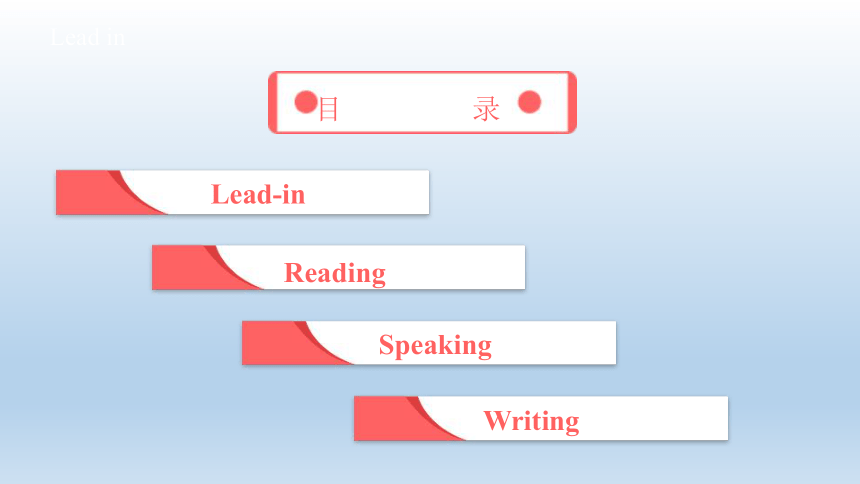
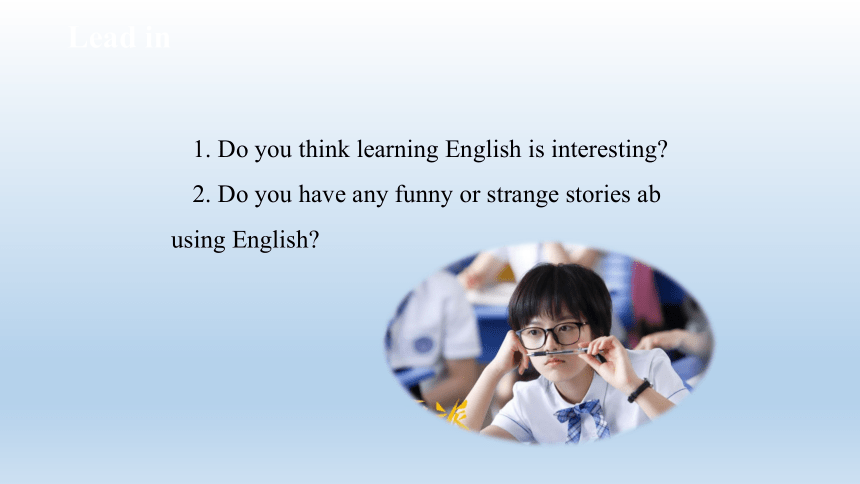
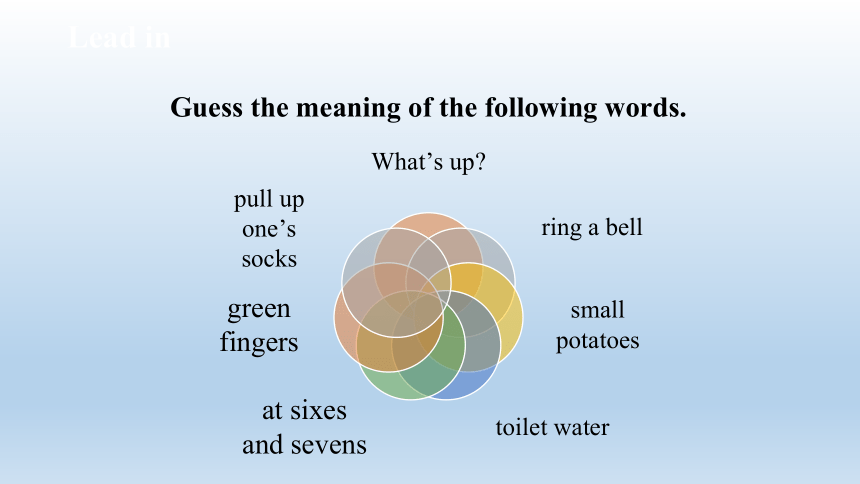
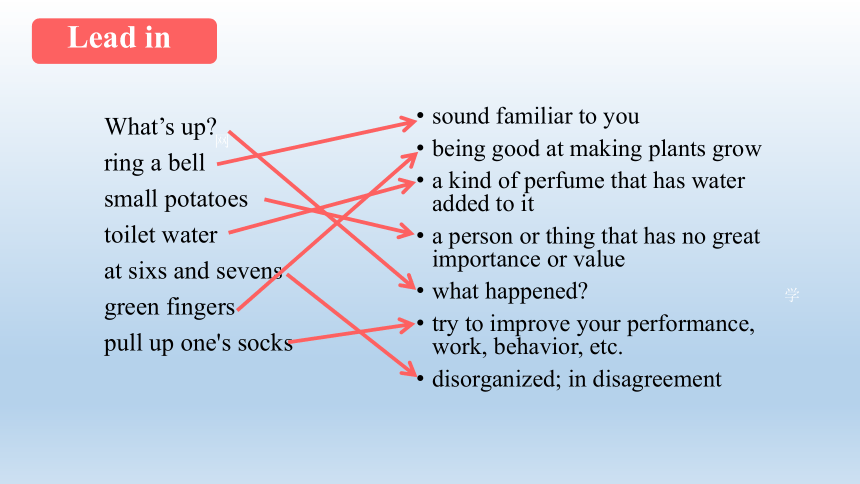
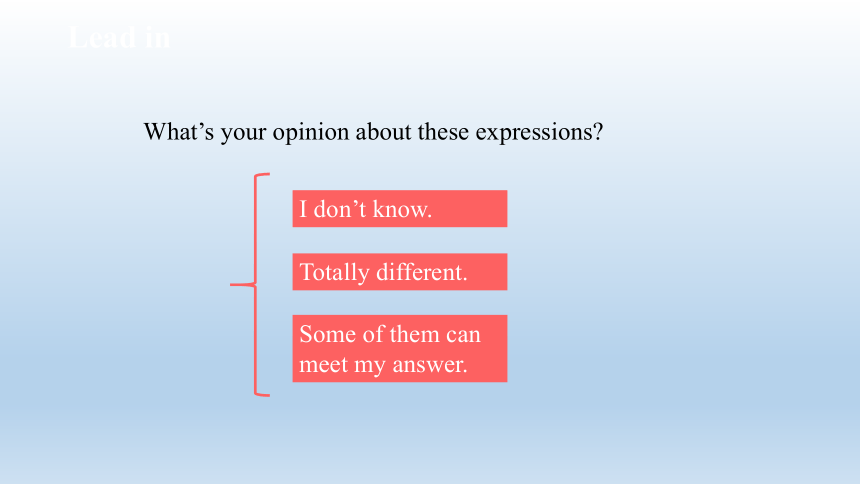
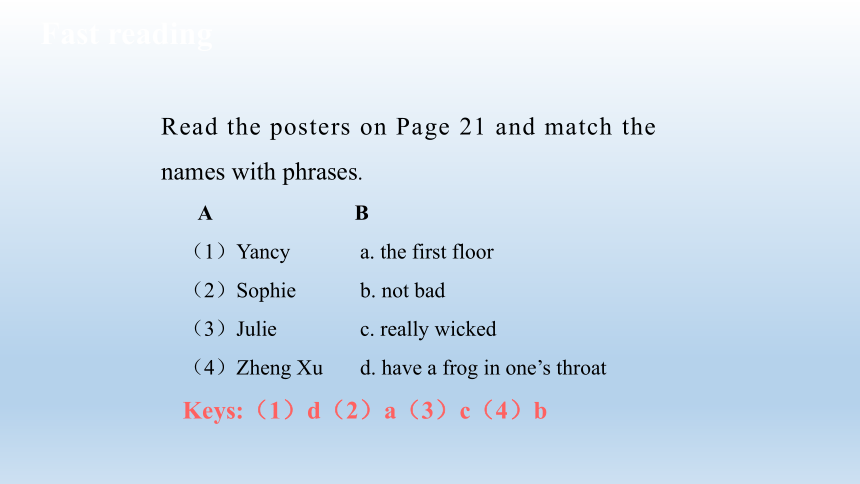
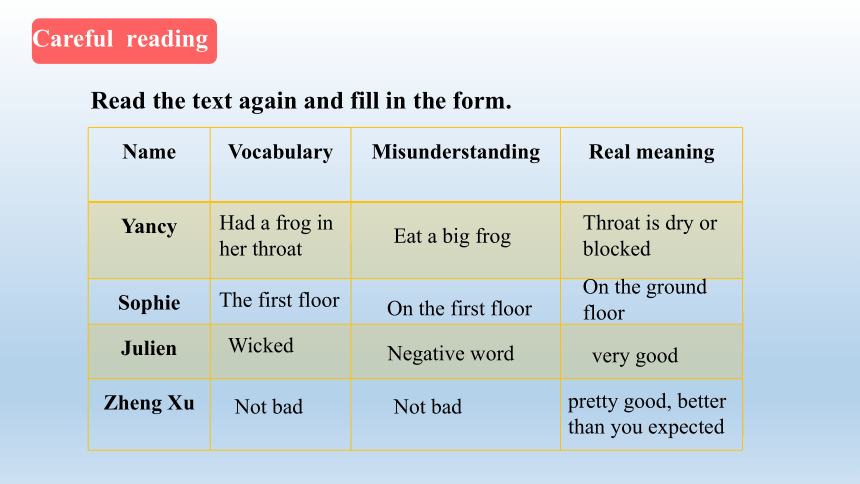

文档简介
(共20张PPT)
Unit 2 Exploring English
目 录
Lead in
Lead-in
Reading
Speaking
Writing
Lead in
1. Do you think learning English is interesting
2. Do you have any funny or strange stories ab using English
Lead in
Guess the meaning of the following words.
What’s up
ring a bell
small potatoes
toilet water
at sixs and sevens
green fingers
pull up one's socks
sound familiar to you
being good at making plants grow
a kind of perfume that has water added to it
a person or thing that has no great importance or value
what happened
try to improve your performance, work, behavior, etc.
disorganized; in disagreement
学
网
Lead in
Lead in
What’s your opinion about these expressions
I don’t know.
Totally different.
Some of them can meet my answer.
Fast reading
Read the posters on Page 21 and match the names with phrases.
A B
(1)Yancy a. the first floor
(2)Sophie b. not bad
(3)Julie c. really wicked
(4)Zheng Xu d. have a frog in one’s throat
Keys:(1)d(2)a(3)c(4)b
Read the text again and fill in the form.
Name Vocabulary Misunderstanding Real meaning
Yancy
Sophie
Julien
Zheng Xu
Careful reading
Had a frog in her throat
Eat a big frog
Throat is dry or blocked
The first floor
On the first floor
On the ground floor
Wicked
Negative word
very good
Not bad
Not bad
pretty good, better than you expected
misadventure __________
remind __________
rather __________
comment __________
downtown __________
boot __________
entrance __________
English to Chinese
exit __________
actually __________
downstairs __________
odd __________
negative __________
error __________
intend __________
错误;冒险
提醒
宁愿
评论
市中心
引导
实际上
退出
退出
楼下
奇数
负数
错误
入口
Post-reading
intend —————
Informal __________
base __________
have a frog in one’s throat ______________________
English to Chinese
打算
section —————
be aware of __________
recognize __________
be aware of __________
非正式
基础
认识
喉咙沙哑
认识
打算
部分
Post-reading
Speaking
Work in pairs. Retell the situations in the four posts.
学
科
网
Speaking
Writing
Read the pictures on P23 and answer the questions below:
Picture 1:
Who was in the picture
Where did the story happen
When did the story take place
Writing
Read the pictures on P23 and answer the questions below:
Picture 2:
What did the boy say to the girl
Picture 3:
What caused the misunderstanding
Picture 4:
What are they doing
Writing
图画类记叙文注意事项:
1. 认真审题明确写作任务。图画类记叙文要交代五个“W”和一个“H”,即:What(什么事),Who(什么人),When(什么时候),Where(什么地点),Why(什么原因),How(怎么样)。整个写作内容的确定、写作材料的筛选,都要围绕这五个“W”和一个“H”进行。
2. 灵活安排写作顺序。图画类记叙文通常是按照事情发展的先后顺序来叙述,但是为了表达的需要,也可以采用倒叙、插叙等方式来叙述。
Writing
3. 合理选择人称。一般来说,英语记叙文多以第一人称(I/We)或第三人称(He/She/It/They)展开叙述。写作时要根据具体情况合理选择。
4. 合理把握时态语态。图画类记叙文一般采用一般过去时或一般现在时。
5. 组织要点。在看懂图画的基础上,最好在草稿纸上逐条列出要点,以免遗漏。若是几幅图,要列出各图的大意,然后将所列要点用完整地道的英语句子表达出来。
6. 连句成篇。首先,在理清句子之间的关系后选用恰当的关联词语,把句子连接成文。其次,要避免句子结构的单调重复。文末应尽量加上适当的结束语,以使文章结构完整。
【增分表达】
1.交代时间常用表达:
2.交代地点常用表达:
3.交代时间地点与相关人物的句型:
One day.../The other day.../Last week...
in my office/in.../on the way to...
(1) sb. was doing sth when sth/sb did sth;
(2) 时间+was memorable because sb did sth;
(3) This particular day began at +时间点+in the morning/afternoon/evening in+地点
Writing
Writing
4. 推动情节发展常用表达:
5.表故事结果常用表达:
6.表感想常用表达:
then, suddenly, immediately, no sooner...than..., hardly...when..., while, when, as, not...until...等。
At last/Finally...,However...,Luckily/Fortunately...,To one’s surprise...
(1) Personally, I think that...;
(2) I learn from the story that...;
(3) I think that this unforgettable and unusual experience will be fresh on my mind forever.
Writing
Write a paragraph to tell the story. Use the expressions in the box to help you.
I was really surprised when…
I wasn’t sure whether…
To my astonishment,…
It turned out that…
Write your own story
Writing
Unit 2 Exploring English
目 录
Lead in
Lead-in
Reading
Speaking
Writing
Lead in
1. Do you think learning English is interesting
2. Do you have any funny or strange stories ab using English
Lead in
Guess the meaning of the following words.
What’s up
ring a bell
small potatoes
toilet water
at sixs and sevens
green fingers
pull up one's socks
sound familiar to you
being good at making plants grow
a kind of perfume that has water added to it
a person or thing that has no great importance or value
what happened
try to improve your performance, work, behavior, etc.
disorganized; in disagreement
学
网
Lead in
Lead in
What’s your opinion about these expressions
I don’t know.
Totally different.
Some of them can meet my answer.
Fast reading
Read the posters on Page 21 and match the names with phrases.
A B
(1)Yancy a. the first floor
(2)Sophie b. not bad
(3)Julie c. really wicked
(4)Zheng Xu d. have a frog in one’s throat
Keys:(1)d(2)a(3)c(4)b
Read the text again and fill in the form.
Name Vocabulary Misunderstanding Real meaning
Yancy
Sophie
Julien
Zheng Xu
Careful reading
Had a frog in her throat
Eat a big frog
Throat is dry or blocked
The first floor
On the first floor
On the ground floor
Wicked
Negative word
very good
Not bad
Not bad
pretty good, better than you expected
misadventure __________
remind __________
rather __________
comment __________
downtown __________
boot __________
entrance __________
English to Chinese
exit __________
actually __________
downstairs __________
odd __________
negative __________
error __________
intend __________
错误;冒险
提醒
宁愿
评论
市中心
引导
实际上
退出
退出
楼下
奇数
负数
错误
入口
Post-reading
intend —————
Informal __________
base __________
have a frog in one’s throat ______________________
English to Chinese
打算
section —————
be aware of __________
recognize __________
be aware of __________
非正式
基础
认识
喉咙沙哑
认识
打算
部分
Post-reading
Speaking
Work in pairs. Retell the situations in the four posts.
学
科
网
Speaking
Writing
Read the pictures on P23 and answer the questions below:
Picture 1:
Who was in the picture
Where did the story happen
When did the story take place
Writing
Read the pictures on P23 and answer the questions below:
Picture 2:
What did the boy say to the girl
Picture 3:
What caused the misunderstanding
Picture 4:
What are they doing
Writing
图画类记叙文注意事项:
1. 认真审题明确写作任务。图画类记叙文要交代五个“W”和一个“H”,即:What(什么事),Who(什么人),When(什么时候),Where(什么地点),Why(什么原因),How(怎么样)。整个写作内容的确定、写作材料的筛选,都要围绕这五个“W”和一个“H”进行。
2. 灵活安排写作顺序。图画类记叙文通常是按照事情发展的先后顺序来叙述,但是为了表达的需要,也可以采用倒叙、插叙等方式来叙述。
Writing
3. 合理选择人称。一般来说,英语记叙文多以第一人称(I/We)或第三人称(He/She/It/They)展开叙述。写作时要根据具体情况合理选择。
4. 合理把握时态语态。图画类记叙文一般采用一般过去时或一般现在时。
5. 组织要点。在看懂图画的基础上,最好在草稿纸上逐条列出要点,以免遗漏。若是几幅图,要列出各图的大意,然后将所列要点用完整地道的英语句子表达出来。
6. 连句成篇。首先,在理清句子之间的关系后选用恰当的关联词语,把句子连接成文。其次,要避免句子结构的单调重复。文末应尽量加上适当的结束语,以使文章结构完整。
【增分表达】
1.交代时间常用表达:
2.交代地点常用表达:
3.交代时间地点与相关人物的句型:
One day.../The other day.../Last week...
in my office/in.../on the way to...
(1) sb. was doing sth when sth/sb did sth;
(2) 时间+was memorable because sb did sth;
(3) This particular day began at +时间点+in the morning/afternoon/evening in+地点
Writing
Writing
4. 推动情节发展常用表达:
5.表故事结果常用表达:
6.表感想常用表达:
then, suddenly, immediately, no sooner...than..., hardly...when..., while, when, as, not...until...等。
At last/Finally...,However...,Luckily/Fortunately...,To one’s surprise...
(1) Personally, I think that...;
(2) I learn from the story that...;
(3) I think that this unforgettable and unusual experience will be fresh on my mind forever.
Writing
Write a paragraph to tell the story. Use the expressions in the box to help you.
I was really surprised when…
I wasn’t sure whether…
To my astonishment,…
It turned out that…
Write your own story
Writing
